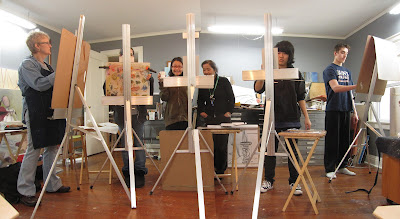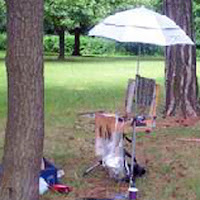 |
| The model’s eye point of view… |
Studio in Art
Saturday, 10-1
Tuesday, 2:30-5:30
(Oil, pastel, acrylic, watercolor)This class focuses on still life as a fundamental tool for developing drawing and painting technique. It is appropriate for both beginning and advanced students. Instruction emphasizes direct painting, where paint is applied solidly rather than through glazing. For watercolor and acrylic, the emphasis is on alla prima techniques.
High school juniors and seniors interested in pursuing a BFA are especially encouraged to sign up for this class. I have an excellent track record in helping students develop outstanding college portfolios.
$100/month
Open Model Sessions, by invitation only
Our open model sessions are moved to Friday afternoons. Please contact me if you want more information.
Autumn is always a difficult time to schedule, since I have obligations elsewhere and there is a surfeit of holidays. If your class is cancelled, you have the option of taking the other class that week, receiving a refund, or taking a private lesson. Just ask me.
The schedule, as it currently appears
Note: we will still be painting outside, as long as the weather permits.
September, 2012
Tuesday 9/11/2012 Open studio class 2:30-5:30 PM
Saturday 9/15/2012 Open studio class 10 AM-1 PM
Tuesday 9/18/2012 Open studio class 2:30-5:30 PM
Saturday 9/22/2012 Open studio class 10 AM-1 PM
Tuesday 9/25/2012 Open studio class 2:30-5:30 PM
Saturday 9/29/2012 NO CLASS: workshop 10 AM-1 PM
October, 2012
Tuesday 10/2/2012 NO CLASS: workshop 2:30-5:30 PM
Saturday 10/6/2012 Open studio class 10 AM-1 PM
Tuesday 10/9/2012 Open studio class 2:30-5:30 PM
Friday 10/12/2012 Model 2 to 5 PM
Saturday 10/13/2012 Open studio class 10 AM-1 PM
Tuesday 10/16/2012 Open studio class 2:30-5:30 PM
Saturday 10/20/2012 Open studio class 10 AM-1 PM
Tuesday 10/23/2012 Open studio class 2:30-5:30 PM
Friday 10/26/2012 Model 2 to 5 PM
Saturday 10/27/2012 No CLASS 10 AM-1 PM
Tuesday 10/30/2012 Open studio class 2:30-5:30 PM
November, 2012
Saturday 11/3/2012 Open studio class 10 AM-1 PM
Tuesday 11/6/2012 Open studio class 2:30-5:30 PM
Friday 11/9/2012 Model 2 to 5 PM
Saturday 11/10/2012 Open studio class 10 AM-1 PM
Tuesday 11/13/2012 Open studio class 2:30-5:30 PM
Saturday 11/17/2012 Open studio class 10 AM-1 PM
Tuesday 11/20/2012 Open studio class 2:30-5:30 PM
Saturday 11/24/2012 NO CLASS: Thanksgiving 10 AM-1 PM
Tuesday 11/27/2012 Open studio class 2:30-5:30 PM
Friday 11/30/2012 Model 2 to 5 PM
December, 2012
Saturday 12/1/2012 Open studio class 10 AM-1 PM
Tuesday 12/4/2012 Open studio class 2:30-5:30 PM
Friday 12/7/2012 Model 2 to 5 PM
Saturday 12/8/2012 Open studio class 10 AM-1 PM
Tuesday 12/11/2012 Open studio class 2:30-5:30 PM
Friday 12/14/2012 Model 2 to 5 PM
Saturday 12/15/2012 Open studio class 10 AM-1 PM
Tuesday 12/18/2012 Open studio class 2:30-5:30 PM
Friday 12/21/2012 Model 2 to 5 PM
Saturday 12/22/2012 Open studio class 10 AM-1 PM
Tuesday 12/25/2012 NO CLASS: Christmas 2:30-5:30 PM
Saturday 12/29/2012 NO CLASS: Holiday 10 AM-1 PM
Tuesday 1/1/2013 NO CLASS: Holiday 2:30-5:30 PM











